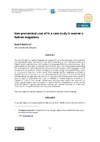Please use this identifier to cite or link to this item:
https://accedacris.ulpgc.es/jspui/handle/10553/70385
| Title: | Non-pronominal uses of it: a case study in women’s fashion magazines | Authors: | Balteiro Fernández, Isabel | UNESCO Clasification: | 570107 Lengua y literatura 550510 Filología |
Keywords: | Anglicisms pseudo-Anglicisms Non-pronominal it Conversion Fashion language |
Issue Date: | 2018 | Journal: | LFE. Revista de Lenguas para Fines Específicos | Abstract: | The use of English as a global language has largely affected other languages, both in general and specialized areas, particularly at the lexical level due to themassive borrowing of English words. Anglicisms are most visible in the language of fashion, where they are highly appreciated and associated to prestige and “coolness”, apart from linguistically representing the rapid advances and modernization of fashion that sometimes make languages unable to cope with the speed with which extralinguistic realities change. The present study, based on a sample of over four million words from leading fashion magazines published in Spanish, focuses on the use of itin its non-pronominal uses, that is, it aims at identifying and describing the adjectival uses of itwhich may be either directly taken from English in short phrases or compounds like it girl, or adapted to Spanish linguistic contexts as in “calzadoit”,“más it”,“lait prenda”. Furthermore, the study also reveals new uses of it, or rather pseudo-English uses that appear in Spanish fashion magazines and which are the result of different linguistic phenomena. In particular, nominal uses like “la ‘it’ del mes”, “todas las it”or “nuestrasits favoritas” have been detected. El uso del inglés como lengua global ha afectado en gran medida a otros idiomas, tanto en general como en campos especializados, sobre todo en el nivel léxico, debido al préstamo masivo de palabras inglesas. Los anglicismos son especialmente visibles en el lenguaje de la moda, campo en el que son muy apreciados al ser considerados como prestigiosos y “cool”, aparte de que representan lingüísticamente los rápidos avances y progreso de la moda, que hacen que las lenguas a veces no puedan mantener el ritmo de cambios experimentados por las realidades extralingüísticas. El presente estudio, basado en una muestra de más de cuatro millones de palabras compiladas de revistas de moda destacadas y publicadas en español, se centra en el uso de it en sus usos no pronominales, esto es, pretende identificar y describir los usos adjetivales de it que pueden, bien provenir directamente del inglés en compuestos o sintagmas breves, como “it girl”, o bien adaptarse a contextos lingüísticos españoles, como en “calzado it”, “más it”, “la it prenda”. Además, el estudio también revela nuevos usos de “it” como pseudoanglicismos que aparecen en revistas de moda españolas, y que son resultado de fenómenos lingüísticos diferentes. Así, se han detectado, entre otros, usos nominales como “la ‘it’ del mes”, “todas las it” o “nuestras its favoritas”. |
URI: | https://accedacris.ulpgc.es/handle/10553/70385 | ISSN: | 1133-1127 | DOI: | 10.20420/rlfe.2018.221 | Source: | LFE. Revista de lenguas para fines específicos [eISSN 2340-8561], v. 24 (1), p. 18-46 |
| Appears in Collections: | Artículos |
Page view(s)
47
checked on Mar 9, 2024
Download(s)
57
checked on Mar 9, 2024
Google ScholarTM
Check
Altmetric
Share
Export metadata
Items in accedaCRIS are protected by copyright, with all rights reserved, unless otherwise indicated.
